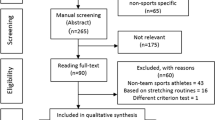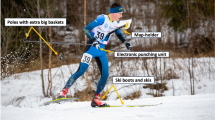Abstract
While ACL injury mechanisms in skiers using traditional skis are well studied, no study has yet investigated the distribution of injury mechanisms in carving skiers. In traditional skiers, the backward twisting fall seems to be the dominant injury mechanism, especially in female skiers. Female recreational skiers have a threefold higher risk to sustain an ACL injury than male skiers; therefore, it is important to determine if carving skis influence the distribution of injury mechanisms and the related frequencies of ACL injuries in female skiers. We investigated the frequencies of injury mechanisms and related factors in 65 ACL-injured female carving skiers by questionnaire. The forward twisting fall was the most reported ACL injury mechanism with about 51%, followed by the backward twisting fall within 29% of cases. Catching an edge of the ski (59 vs. 24%, P = 0.03) when executing turns (69 vs. 41%, P = 0.053) was a more frequent cause for forward twisting falls than for the other types of falling. While 29% of bindings released during a forward twisting fall, only 3.1% released during the remaining mechanisms. In contrast to traditional skiers, the forward twisting fall was the dominant injury mechanism in female carving skiers with ACL injury.
Similar content being viewed by others
References
Bahr R, Krosshaug T (2005) Understanding injury mechanisms: a key component of preventing injuries in sport. Br J Sports Med 39:324–329
Beynnon BD, Ettlinger CF, Johnson RJ (2007) Epidemiology and mechanisms of ACL injury in alpine skiing. In: Hewett TE, Shultz SJ, Griffin LY (eds) Understanding and preventing noncontact ACL injuries. American Orthopaedic Society for Sports Medicine. Human Kinetics, Champaign, pp 183–188
Burtscher M, Nachbauer W (1999) Injury risk of Austrian skiers and comparison of the injury pattern of traditional and carving skiers. In: Österreichisches Kuratorium für Alpine Sicherheit (eds) Sicherheit im Bergland, Innsbruck, Austria, pp 107–115 (in German)
Burtscher M, Gatterer H, Flatz M, Sommersacher R, Woldrich T, Ruedl G, Hotter B, Lee A, Nachbauer W (2008) Effects of modern ski equipment on the overall injury rate and the pattern of injury location in Alpine skiing. Clin J Sport Med 18:355–357
Burtscher M, Sommersacher R, Ruedl G, Nachbauer W (2009) Potential risk factors for knee injuries in alpine skiers. Journal of ASTM International 6:1–4
Ekeland A, Sulheim S, Rodven A (2003) Injuries in Norwegian ski resorts 2000–2002. In: Abstract book of the 15th international congress on skiing trauma and skiing safety. St. Moritz/Pontressina, Switzerland, pp E1–E3
Ettlinger CF, Johnson RJ, Shealy JE (2006) Functional and release characteristics of alpine ski equipment. In: Johnson RJ, Shealy JE, Yamagishi T (eds) Skiing trauma and safety: sixteenth volume. ASTM, Mayfield, pp 65–74
Goulet C, Hagel BE, Hamel D, Legare G (2009) Self-reported skill level and injury severity in skiers and snowboarders. J Sci Med Sport (Epub ahead of print)
Greenwald RM, Toelcke T (1997) Gender differences in alpine skiing injuries: a profile of the knee-injured skier. In: Johnson RJ, Mote CD, Ekeland E (eds) Skiing trauma and safety: eleventh volume. ASTM, Baltimore, pp 111–121
Hagel B (2005) Skiing and snowboarding injuries. Med Sport Sci 48:74–119 (review)
Hewett ET (2000) Neuromuscular and hormonal factors associated with knee injuries in female athletes. Sports Med 29:313–327
Hewett TE, Meyer GD, Ford KR (2006) Anterior cruciate ligament injuries in female athletes: Part 1, mechanism and risk factors. Am J Sports Med 34:299–311
Hintermeister RA (1997) What do we know about super-side skis? Sportverletz Sportschaden 11:137–139
Hull ML (1997) Analysis of skiing accidents involving combined injuries to the medial collateral and anterior cruciate ligaments. Am J Sports Med 25:35–40
International Organization for Standardization (2004) Assembly, adjustment and inspection of an alpine ski/binding/boot (S-B-B) system ISO 11088, Geneva, Switzerland
Järvinen M, Natri A, Laurila S, Kannus P (1994) Mechanisms of anterior cruciate ligament ruptures in skiing. Knee Surg Sports Traumatol Arthrosc 2:224–228
Johnson RJ, Ettlinger CF, Shealy JF, Meader C (1997) Impact of super side cut skis on the epidemiology of skiing injuries. Sportverletz Sportschaden 11:150–152
Johnson RJ, Ettlinger CF, Shealy JF (2006) Injury trends, risk factors involving ACL injuries in alpine skiing. Abstracts of the sixteenth international symposium on ski trauma, skiing safety, Arai Mountain, Niigata, Japan, 17–23 April 2005. Knee Surg Sports Traumatol Arthrosc 14:101
Köhne G, Kusche H, Schaller C, Gutsfeld P (2007) Ski accidents—changes since introduction of carving ski. Sportorthopädie Sporttraumatologie 23:63–67 (in German)
Krosshaug T, Andersen TE, Olsen OE, Myklebust G, Bahr R (2005) Research approaches to describe the mechanisms of injuries in sport: limitations and possibilities. Br J Sports Med 39:330–339
LaPorte JD, Binet MH, Fenet N, Constans D (2006) Ski bindings and lower leg injuries: a two year case-control study in Avoriaz. Abstracts of the sixteenth international symposium on ski trauma and skiing safety, Arai Mountain, Niigata, Japan, 17–23 April 2005. Knee Surg Sports Traumatol Arthrosc 14:100–101
Laporte JD, Binet MH, Fenet N, Constans D, Joubert P (2009) Ski bindings and lower leg injuries, a case control study in Flaine 2006. In: Johnson R, Shealy J, Langran M (eds) Skiing trauma and safety: seventeenth volume. J ASTM Intl, Bridgeport, pp 77–88
Merkur A, Whelan KM, Kuah E, Choo P (2003) The effect of ski shape on injury occurrence in downhill skiing. In: Johnson RJ, Lamont MK, Shealy JE (eds) Skiing trauma and safety: fourteenth volume. ASTM, Saline, pp 129–139
Nachbauer W, Kaps P (1995) Cruciate ligament forces during landing in downhill skiing, In: Häkkinen K, Keskinen KL, Komi PV, Mero A (eds) Book of abstracts, XVth congress of the international society of biomechanics, Jyväskylä, Finland, 2–6 July 1995, pp 654–655
Nachbauer W, Hoser C, Fink C (2004) Injury mechanisms of anterior cruciate ligament tears in alpine ski racing. Knee Surg Sports Traumatol Arthrosc 12:176
Natri A, Beynnon BD, Ettlinger CF, Johnson RJ, Shealy JE (1999) Alpine ski bindings and injuries. Current findings. Sports Med 28:35–48
Olsen OE, Myklebust G, Engebretsen L, Bahr R (2004) Injury mechanisms for anterior cruciate ligament injuries in team handball: a systematic video analysis. Am J Sports Med 32:1002–1012
Shimokochi Y, Shultz SJ (2008) Mechanisms of noncontact anterior cruciate ligament injury. J Athl Train 43:396–408
Sinning WE (1985) Body composition and athletic performance. In: Clarke DH, Eckert HM (eds) Limits of human performance. The Academy Papers, Champaign, pp 45–56
Sulheim S, Ekeland A, Bahr R (2007) Self-estimation of ability among skiers and snowboarders in alpine skiing resort. Knee Surg Sports Traumatol Arthrosc 15:665–670
Urabe Y, Ochi M, Onari K, Ikuta Y (2002) Anterior cruciate ligament injury in recreational alpine skiers: analysis of mechanisms and strategy for prevention. J Orthop Sci 7:1–5
Werner S, Willis K (2002) Self-release of ski-binding. Int J Sports Med 23:530–535
Yu B, Kirkendall DT, Garret WE (2002) Anterior cruciate ligament injuries in female athletes: anatomy, physiology, and motor control. Sports Med Arthrosc Rev 10:58–68
Acknowledgments
The authors gratefully acknowledge support for this study from the Tiroler Wissenschaftsfond (TWF).
Author information
Authors and Affiliations
Corresponding author
Rights and permissions
About this article
Cite this article
Ruedl, G., Linortner, I., Schranz, A. et al. Distribution of injury mechanisms and related factors in ACL-injured female carving skiers. Knee Surg Sports Traumatol Arthrosc 17, 1393–1398 (2009). https://doi.org/10.1007/s00167-009-0860-7
Received:
Accepted:
Published:
Issue Date:
DOI: https://doi.org/10.1007/s00167-009-0860-7




